Wood Chip as a Mulch
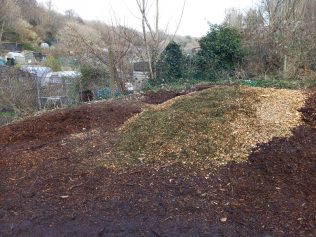
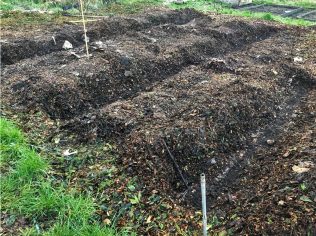
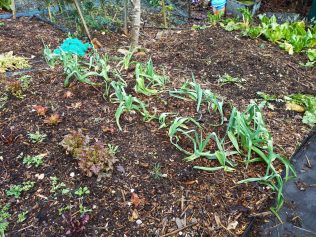
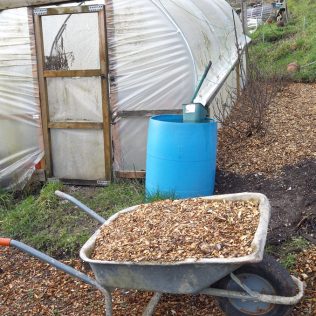
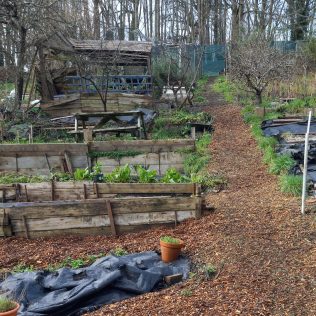
Why Wood chips? Have we lost the plot?
By Nath (Plot 12) and Ellie (Plot 13/1) Moulsecoomb Estate Allotments
We are Nath and Ellie, and between us we are the plot holders of sites 12 and 13/1. Nath first got the half plot (12/1) 8 years ago, and 18 months later Ellie took on 13/1. We have recently started using wood chips as mulch covering our plots, and here we are going to explain our reasons for doing so.
Since we first took on our plots we have taken the normal seasonal approach of digging over of the beds in spring and incorporating compost or green manures so they are ready for seed sowing and planting out; and the rest of the year we try to keep on top of weeding as best we can. We use crop rotation and avoid the use of any chemicals. We have had varying degrees of success with our crops in past seasons, but more recently – and especially this year – we have noticed our soil has become depleted and our crops have struggled. Over the years we have used compost and green manures to improve our soil – although we find that we can never make enough of our own compost, and buying in each year can be expensive, not to mention difficult to coordinate logistically as we don’t have a car.
We balance tending the allotment around working full time among other commitments, and one of the challenges we face is playing catch up with seasonal tasks. So we are always keen to explore methods for low maintenance gardening – work smarter not harder!
The seed to our new approach to our allotment was sown in 2018 when Nath took on the second half of plot 12 with the intention of creating an orchard. This led us to researching more thoroughly Food Forest gardening: a system of no-dig food growing to mimic natural forest systems incorporating different layers of plants including trees, shrubs (i.e. fruit bushes), herbaceous plants, the root zone, ground cover and climbing plants. This winter we have ordered 19 fruit trees, which we will plant over the coming months and will form the ‘canopy layer’ of our food forest. Going forward we will continue to build the layers of our food forest whilst retaining areas where we can grow our annual crops.
Researching food forests in turn led us to learn more about using wood chips as a mulch in the garden as a way to: improve soil health and fertility, build soils and soil life, protect against soil erosion, aid water retention, keep the soil warmer in winter and cooler in summer, suppress weeds, and prevent the compaction of soils, to name a few. Wood chips also allow air to reach the soil to keep the soil and root zone aerated.
Wood chips will be broken down by saprophytic fungi (decomposing fungi), releasing nutrients and matter into the soil for other soil organisms to feed on, including bacteria and other fungi. One way that we can facilitate and take advantage of this process is by introducing edible saprophytic mushrooms, such as shiitake and oyster mushrooms. This is something we are experimenting with at home currently, and we have even come across a strain of shiitake which will decompose both soft and hard woods.
We will also adopt a ‘no dig’ approach allowing mycorrhizal fungi hyphae to grow. Mycorrhizal fungi – often referred to as the ‘Wood Wide Web’ – are networks of fungi underneath the soil surface that connect with plant roots. These mycorrhizal fungi hyphae are essential in plant growth and health as they make water and nutrients available to the plant roots that the plants would otherwise not be able to access. In exchange plants release carbon to the fungi and bacteria in the soil in the form of carbohydrates formed via photosynthesis. The fungi and bacteria then use the carbohydrates to form humus, building soil and sequestering carbon in a form that can stay in the soil for hundreds of years. No dig is essential to this process, as digging the soil breaks up and kills the fungal hyphae strands and other soil organisms.
This also links to research that we have seen from soil scientist Dr Christine Jones that for healthy soils we need to re frame our approach as gardeners to become ‘light farmers’. In other words, ensuring that we can harvest as much light energy as possible year round by having as much ground covered with plants for as much as the year as possible. We hope that by having more permanent plants in our food forest, and by incorporating patches of cover crops and green manure from time to time, it will go some way to achieving this.
The guidance we have seen recommends having a layer of 6 inches of wood chips throughout the entire plot, with the layer thickening to 12 inches under fruit trees, leaving a gap around the trunk/stems so as not to damage the tree. Wood chips don’t need to be rotted down first, freshly chipped wood can be used. The wood chips will gradually be decomposed by soil organisms over the course of a few years, building soil in turn. And as the wood chips break down they can be topped up again to maintain the depth of the mulch.
The method that we have followed is to first lay cardboard down directly on the soil and to layer the wood chips on top. The cardboard is meant to aid initial weed suppression and attract worms to facilitate breaking down the wood chips. In recent years we have noticed that our soils were lacking in worms. In the last few weeks when we pulled some of the wood chips back we were impressed at the number of worms we saw, so we are hopeful that this is a sign that things are moving in the right direction.
We started the process of covering our plots in wood chips about 6 months ago. The first area we tackled we didn’t use cardboard and covered it in about 6 inches of wood chips. This has now reduced to about 2 inches and has remained fairly successful at suppressing weeds. On the plot as a whole we have noticed that so far the wood chips have suppressed pernicious weeds including bind weed and most of the couch grass, although we have seen some dandelions coming through. We did expect that some weeds would come through, but that there would be fewer of them and so easier to maintain, and overtime they will become weaker and die off.
We still plan on growing crops by raking back the wood chips to form rows or patches where we can grow plants. Mainly we plan to start off seeds in modules and then plant out later on, but theoretically it would still be possible to sow directly into the soil when the wood chips have been pulled back. Once the crop is finished, the area can be covered over again with wood chips, with any vegetative growth left underneath to rot down and feed the soil food web. We have just started experimenting with this technique by planting rows of garlic, which currently look like trenches in the wood chips – see picture. We will see how this goes.
To source the wood chips Nath contacted a number of or tree surgeons in the area, and came across Adam from Green Timber. Amazingly Adam agreed to supply wood chips for free – which anyone on the site is welcome to use. He can drop up to four cubic metres a week, so there should be no shortage!
The wood chips we have acquired are a mixture of both woody and leafy material, as well as both soft and hard woods. The mix of both green and brown materials is supposed to aid decomposition, and the variety of materials is supposed to be beneficial for a diverse soil life.
It is widely thought that woods from softwoods/conifers will make the soil acidic, however we have found information which concludes that in fact by the time that woody material is decomposed by fungi its acidity is neutralised, so will not affect the pH of the soil.
Additionally, we have seen research refuting the idea that woody material robs the soil of nitrogen. They claim instead that this only applies to the surface of the soil, whereas nitrogen in the root zone is not affected. This is as long as wood chips are not mixed in to the soil and stay on the surface. And once the wood chips are decomposed by the soil life, nitrogen availability in the soil is increased as it released by the soil organisms that were breaking down the woody material. We have also seen some sources say that if the wood chips are partially decomposed and colonised with fungi they can be mixed into the soil. So as long as there is soil life to breakdown the wood chips we should be ok.
We hope that our no dig ‘wood chip way’ will help us to build healthy soils and plants with year round fertilisation, to have more successful and reliant harvests, and whilst being time efficient and doing our bit for the planet too. Time will tell – watch this space!
Below are some suggestions for sources, links and people that we have found useful and interesting when researching the above and planning our no-dig, wood chip, food forest:
· Food Forests – this article gives an overview: https://www.permaculturenews.org/2011/10/21/why-food-forests/
· Soil scientist Dr Christine Jones – there are many youtube videos of Dr Christine Jones talks
· Soil scientist Dr Elaine Ingham – many useful youtube videos featuring Dr Elaine Ingham on the ‘Soil Food Web’ and building healthy soils
· Matt Powers – The Permaculture Student – a youtube channel: https://www.youtube.com/user/permaculture123
· The One Yard Revolution – a youtube channel: https://www.youtube.com/c/OneYardRevolution
· The Gardening Channel with James Prigioni: https://www.youtube.com/c/jamesprigioni
· Fungi – an interesting article that describes the roles and functions of fungi – https://permacultureapprentice.com/food-forest-fungi/





Comments about this page
This is great, well done in the research and in bothering to write it up. I am also on Roedale plots and have been using woodchip all over all the beds as a compost replacement in no-dig methods. I’ve been inoculating the woodchip with king stropharia mushrooms, also known as wine caps, which have fruited well and have rotten the woodchip quickly. It’s self sustaining now, each time you bring fresh wood chip you mix in a few shovels of well inoculated woodchip from the mother bed…!! I’ll try and come and find you, bring you a barrow of inoculated woodchip you can mix in to yours. It’s a win win – quick release of the nutrient locked up in the woodchip, limitless free mulch/compost and edible mushrooms..!
Great News about the Newly shredded tree’s . Now I don’t have to have the Great Pile on the Front of the Garden. I can now use it Whenever. Thank You.
Thank you for sharing your experience and research!
Would love to hear how’s things are progressing. I’ve mulched my fruit tress with fresh woodchip and done paths. I’m now wondering about no dig potatoes.
Add a comment about this page